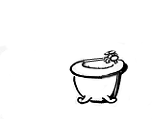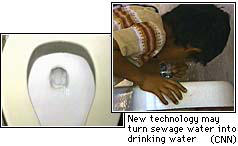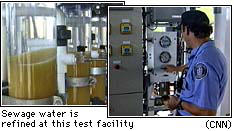
Atlantis Solar






Tel: 916-226-9183 | Save Paper Use PDF: | Email: sales@atlantissolar.com
®
Every one is plugging in! “Go Green”
®


Prescription drugs and sewage found in drinking water across the world.
CNN
"Example" Wastewater to tap in many states & countries
Municipal wastewater consists primarily of domestic wastes from households, and industrial wastewater from manufacturing and commercial activities.
Both types of wastewater are collected in sanitary or combined sewers, and are usually treated at a municipal wastewater treatment plant. After
treatment, the wastewater is discharged to its receiving water (e. g., a river, an estuary, or an ocean).
The City of Atlanta’s Bureau of Wastewater Services (Department of Watershed Management) operates the wastewater collection, conveyance and
treatment system, which consists of approximately 2,000 miles of sanitary and combined sewers, six Combined Sewer Overflow (CSO) treatment plants,
four water reclamation centers (WRCs) and sixteen pump stations. The WRCs treat more than 170 million gallons of wastewater per day. The high quality,
treated effluent from the City’s WRCs is discharged into the Chattahoochee River, one of Georgia's most important water resources.
The City of Atlanta has a population of approximately 400,000 and is the central hub of an urban metropolis of more than 4 million. The city’s wastewater
system serves more than 1.5 million people who commute to the city to work or who live outside the city in Dekalb, Fulton, and Clayton counties.
Toilet water on tap?
Many cities hope to recycle waste water
April 25, 1997
Web posted at: 6:46 p.m. EDT (2246 GMT)
From Correspondent Charles Feldman
Many cities (CNN) -- While Many cities there are many natural and man-made riches, water isn't one of them. The city imports 90 percent of its water
from the Rivers and the state water project. But engineers have flushed out a startling solution to the region's water woes.
If all goes according to plan, by the year 2001, many city's sewage water will be treated and recycled right into the drinking tap.




"This project is the first of its kind in America," said a water engineer of the Water Authority. "We are taking reclaimed water, which is essentially treated
waste water, and bringing it back to the point where it is suitable for drinking."
The idea of turning waste water into drinking water may see repulsive to some, but experts say it's already being done elsewhere on a smaller scale.
And besides, they say, the water from the Rivers -- the city's main supply -- already has to be treated to remove all types of pollution.
The method is being employed at a small test facility, where waste water is piped through a complex maze of equipment, including a membrane that
removes the nasty stuff.
When the process is done for real on a large scale, the treated water will first get pumped into a reservoir for further refinement, because of health
department concerns that the process may not be completely effective.
Australia-Led by one of Toowoomba's wealthiest citizens, the developer Clive Berghofer, recycling naysayers claim property prices will tumble and
businesses fail when word gets out that the towns taps are flowing with treated sewage.
"I dont want my city to die," Mr Berghofer said.
He said he had lost three property sales recently because buyers did not want to live in a town where residents drank recycled water.
Cr Thorley scoffs at the critics and stands by her decision to push the project through.
"There is only one question to be answered," she said. "Is this water pure enough to drink? And the answer is yes. All the rest of this stuff is argy-bargy and
people playing games."
This is not just a debate about the science of recycling, as a group of experts from the Australian Water Association discovered on Saturday at a forum
attended by 250 Toowoomba residents.
After delivering lectures, the panel of engineers, microbiologists and environmentalists faced a barrage of questions about their independence from the
council, perceived conflicts of interest, and whether water treatment technology could protect people from contaminants that might still be unknown.
The chairman of Clean Up Australia, Ian Kiernan, who was on the panel, said it was a matter of trust. "I am 100 per cent convinced that potable reuse is the
way of the future," he said. "So I am asking the people of Toowoomba to go with us."
KARACHI-Potable water reaches a household through a network of iron pipes. Even in relatively new settlements of the city these pipes have become
worn-out. In the old town areas, these pipes are rusted. Running side by side to these water lines are sewage lines. This arrangement is prevalent in almost
every township of the city. As the water supply is intermittent, it creates a pipeline vacuum, and if sewage line passing close by is choked it finds its way
into the water supply line resulting in contamination, says Professor Noman Ahmed. The water supply is intermittent. When it slows down a vacuum is
created. If a nearby sewage line is full to the choking point, there is a seepage of sewage into the water line, resulting in serious contamination, reports
Professor Noman Ahmed.

A Tall, Cool Drink of ... Sewage?
The world to Drink More Treated Sewage
By Robert Roy Britt, LiveScience Managing Editor
posted: 28 January 2008 08:49 am ET
In a recent episode of "Man vs. Wild," survival expert Bear Grylls pees in his canteen and promptly drinks the warm liquid, cringing as he does every week
at doing something gross, this time in order to survive being dropped in the middle of the scorching Australian Outback for our viewing pleasure.
Apparently, as long as you don't let it sit around too long and allow bacteria to fester, your pee is perfectly sterile and, importantly, made mostly of water.
But mix the pee with your neighbors poo and all the other effluent of a sewage system, and the thought of drinking the treated end product makes most
of us squirm even more than a contrived scene in a reality show.
However, with water supplies tightening around the country due to growing populations and drought, many communities are considering tapping their
sewage treatment plants as a new source of drinking water.
'Scrambling'
In the Jan. 28 issue of Chemical & Engineering News, a publication of the American Chemical Society, Associate Editor Jyllian Kemsley writes: "Water
utilities are scrambling to find new ways to meet the demand for one of life’s essentials."
U.S. scientists have warned that parts of the world will soon need to find new sources of drinking water. The United Nations calls thirst a growing global
crisis. Desalination, while it works, remains too expensive to be practical for most areas.
Reclaimed wastewater has long been returned to the environment or used for irrigation.
In the Southwest, where water has always been scarce, elaborate systems are already in place to reclaim wastewater. The master-planned community of
Anthem, at the edge of Phoenix, uses treated wastewater to irrigate two golf courses and acres upon acres of parks. But drinking water for the roughly
25,000 residents still comes from the Colorado River.
And as an example of the rising costs of water and all its attendant schemes, Anthem residents are currently facing up to a 50 percent increase in water
rates this year and more in coming years to pay for the reclamation facility. Residents are up in arms over the unexpected rate hike and what they see as
a lack of disclosure on the part of the builder and the local water company about the plant's true costs.
Already drinking it
Elsewhere in the world, treated wastewater is already finding its way into water glasses.
Recycled water flows into a stream that feeds Virginia's Occoquan Reservoir, Kemsley notes. "In Los Angeles, treated wastewater is added to the
Montebello Forebay, where it percolates through the soil to replenish the groundwater supply. Also in Many cities, the Orange County Water District’s
(OCWD’s) Water Factory 21 facility reclaims wastewater that is then injected into aquifers to provide a pressurized barrier against seawater intrusion into
groundwater."
Earlier this month, Many cities approved operation of the Advanced Water Purification Facility (AWPF), the largest water reclamation plant in the nation.
It will produce 70 million gallons a day of drinkable water from sewage — supplying about 10 percent of the water needed for the district's 2.3 million
residents.
Kemsley explains how the facility reduces levels of organic chemicals, pathogens and pharmaceuticals:
•
Big stuff like tree limbs are removed.
•
Coffee grounds and other granulars settle out.
•
Chemicals are added to encourage gunk to clump and settle out.
•
Bacteria are added to break down poo.
Now it's ready for discharge into the ocean. To make it drinkable:
•
Sodium hypochlorite is added to disinfect the water, which then goes through microfilters.
•
The water is treated with reverse osmosis, a process used in some home-water filters, to remove dissolved contaminants.
•
Finally, hydrogen peroxide is added and the water is irradiated with ultraviolet light to removed the last of the organic


Here is a very disturbing video about the tap water that we drink. I am not sure if this is true but just looking at it makes me sick. I hope someone can tell
me that this is not true. Tampon and toilet paper residue in our tap water?
VIDEO->
H2-OH-MY

Copyright 2003-2018 © Atlantis Solar®, All rights reserved.
Every one is plugging in ! ®
CBS News
CNN News














